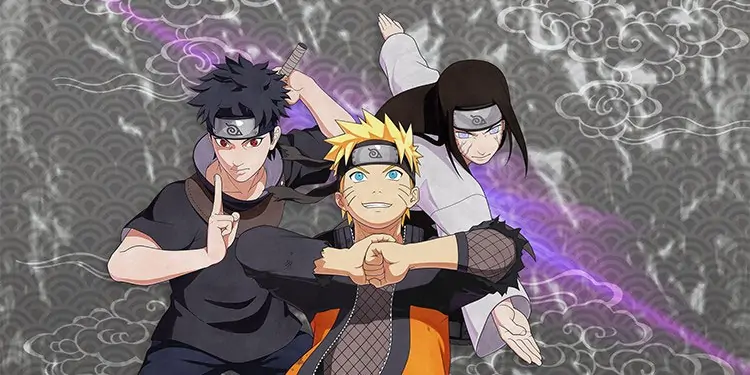Naruto is one of the most popular Shounen anime of all time. Naturally, there’re dozens of Naruto games across various genres, believe it!
We’re running down the list of Naruto entries available worldwide. Therefore, we’re not considering titles that have never premiered outside of Japan.
For example, the franchise’s first game is Naruto: Gekitou Ninja Taisen, only available in Japan. It belongs to the Saikyou Ninja Daikesshu series, which we know as Naruto: Clash of Ninja and Naruto: Ninja Council.
Most Naruto games are 2D fighting titles. The most iconic series is Naruto Ultimate Ninja storm by CyberConnect2 (also creators of the Demon Slayer game). Either way, here’re the Naruto games we found available outside of Japan:
- Naruto: Clash of Ninja series – 5 games
- Naruto: Ninja Council Series – 7 games
- Naruto: Ninja Destiny – 2 games
- Naruto: Path of the Ninja – 3 games
- Uzumaki Chronicles – 4 games
- Naruto: Ultimate Ninja – 15 games
- Others – 5 games
The total is 41 Naruto games.
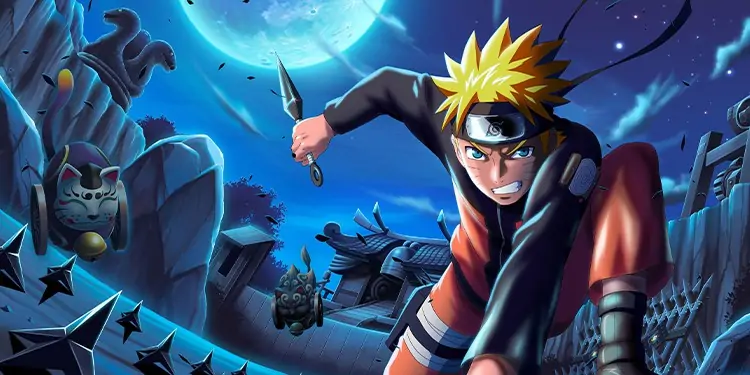
Naruto Games in Order
Naruto: Clash of Ninja 1 – April 2003
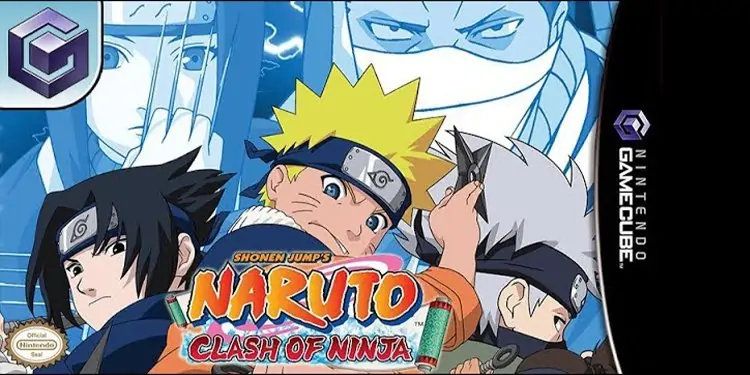
The first worldwide Naruto game is Clash of Ninjas. It debuted a year after the anime’s debut, taking events and inspirations from the manga. It premiered for GameCube in 2003.
This is a 1v1 2D fighting game with 3D backgrounds. Players could pick characters from the manga or the show and fight against each other. It also has a single-story mode where you follow the event of the series through dialogue and fights.
Naruto: Ninja Council – May 2003
Ninja Council debuted in 2003 for Game Boy Advance. It’s a single-player game that loosely follows the Chunin Exam arc.
This is an action platformer that follows a character through 2D environments. Along the way, you collect items, defeat enemies, and reach the end goal. Additionally, players could collect scrolls on the maps. They enable special abilities at the cost of Chakra.
Naruto: Ultimate Ninja – October 2003
The first game in the popular Ultimate Ninja series debuted in 2003 for PlayStation 2. However, it became available outside of Japan in 2006.
The series brings a more complex 2D battle system. Characters can block, dodge, perform Jutsus, combos, and more. That said, the game has a story mode and a versus mode. The story has dialogues, cut-scenes, and battles around the Chunin Exam era. Then, the versus mode allows players to fight against the AI or another player.
Naruto: Clash of Ninja 2 – December 2003
The Clash of Ninja Sequel debuted in 2003 for GameCube in Japan. For the rest of the world, the title became available in 2006.
Clash of Ninja 2 brought 26 characters from Ninja Academy and Chunin Exam arcs. It also has features players can unlock by completing tasks and earning in-game currency.
Naruto: Ninja Council 2 – April 2004
The Ninja Council follow-up debuted in 2004 for Game Boy Advance. A European version debuted for Nintendo DS in 2005.
Like the previous entry, it’s an action 2D platformer leaning into the beat ’em-up genre. Playable characters are Naruto, Sasuke, Sakura, and Rock Lee. It loosely follows the anime events up to the Tsunade arc.
Naruto: Path of the Ninja – July 2004
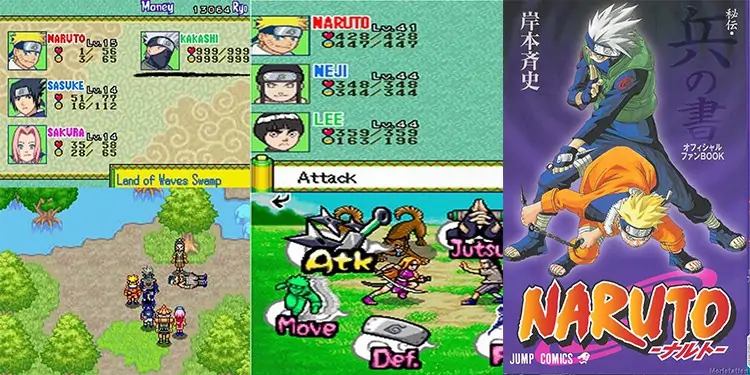
Path of the Ninja debuted for Game Boy Advance in 2004. It opens up a JRPG series where you play with Naruto as the lead of a party.
Characters can move across multiple scenarios to follow a long single-player campaign. The story comes through cut-scenes, dialogue, and turn-based battles.
Naruto: Ultimate Ninja 2 – September 2004
The next entry in the fighting game series debuted in 2004 for PlayStation 2. However, it premiered in North America and Europe in 2007.
The game replaces the arcade single.-player campaign with an RPG mode. You play through the original events up to episode 96. Another novelty is how the game allows you to choose any character to support Shinobi.
Naruto: Ninja Council 3 – April 2005
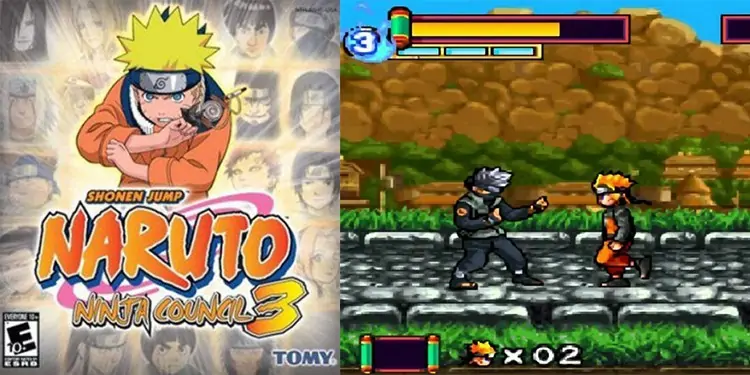
Ninja Council 3 premiered for Nintendo DS in 2005. It’s another action side-scroller with Ninjas and animals as common enemies.
It has similar gameplay as the last titles in the series. However, the missions happen on small maps, and the touch screen showcases the map and offers means to perform Jutsus. Lastly, it adds boss battles.
Naruto: Uzumaki Chronicles – August 2005
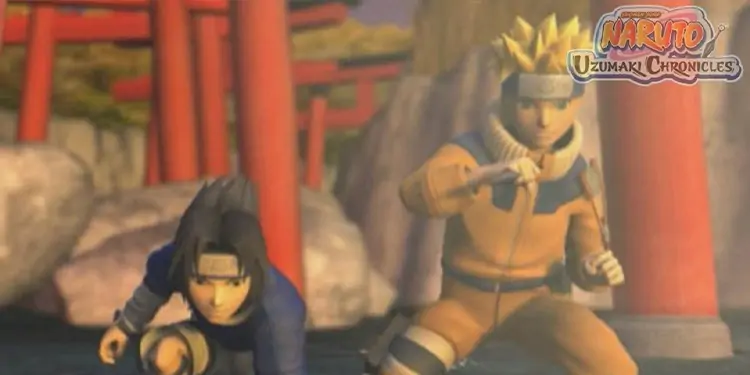
Uzumaki Chronicles debuted for PlayStation 2 in 2005. It’s the first Naruto game for the Sony home console. Unlike the other games, it’s a 3D action platformer.
The title follows an original plot. It’s about completing missions with different characters, some of which are part of the main quest. As usual, you complete these tasks by 1v1 fighting, and some of these battles are against bosses like Gaara or Orochimaru.
Naruto Ultimate Ninja 3 – December 2005
The next entry debuted in 2005 for PlayStation 2 as well. It has a larger character rooster compared to the previous entry, equipable items, and equipable Ultimate Jutsus.
The installment also introduces temporary transformations (like Rock Lee’s Inner Gates) and Jutsu clashes. As for the single-player, it expands the RPG elements with items, cut-scenes, and summons. However, there’re no support characters anymore.
Naruto: Ultimate Ninja Heroes 2: The Phantom Fortress – March 2006
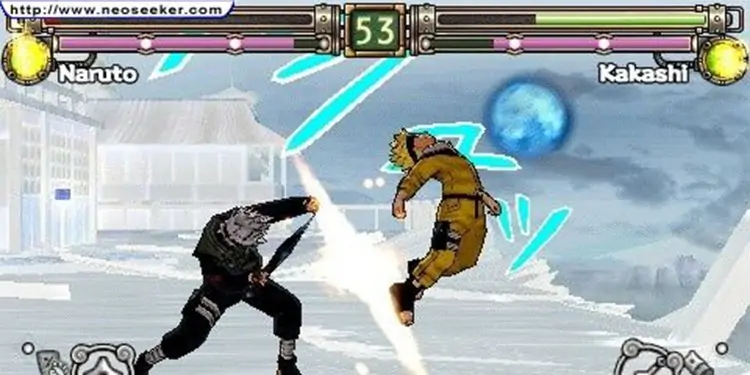
Because of translation issues, the first part of the Ultimate Ninja Heroes series debuted after the sequel. That said, Heroes 2 debuted in March 2006 for PSP.
It has similar gameplay to previous Ultima Ninja titles, but it’s easier to learn. Also, it has an original story where Naruto and others fight across 130 levels of a haunted castle.
Naruto: Ninja Destiny – December 2006
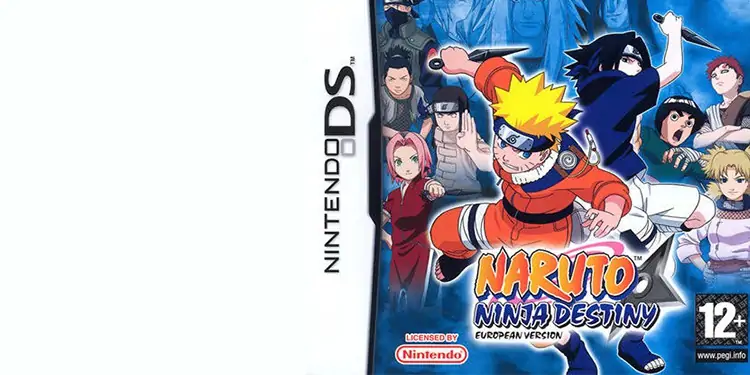
Ninja Destiny debuted in 2006 for Nintendo DS.
It has two game modes, battle and single-player. The first is free fighting against the AI with unlocked characters. The campaign follows the events of the Chunin Exam through dialog, cut-scenes, and battles.
Naruto Shippūden: Ultimate Ninja 4 – April 2007
Ultimate Ninja 4 debuted for PlayStation 2 in 2007 (Japan) and 2009 (worldwide). It introduces Naruto Shippūden characters and events, with over 52 playable characters. Also, it covers up until the Gaara Rescue arc, but it also has some filler events.
The graphical style changes to imitate the anime look. Also, the single-player campaign, the Master Mode, expands the RPG features. Players can explore the massive Naruto world on multiple semi-open maps, plus a sandbox design to complete the missions.
Naruto: Ultimate Ninja Heroes – August 2007
Ninja Heroes debuted in 2007 for PSP. It’s a scaled-down port or version of Naruto: Ultimate Ninja 2.
For novelties, the game has a 3v2 battle system. The first team to defeat all of the enemies gets the victory.
Naruto: Uzumaki Chronicles 2 – September 2007
Uzumaki Chronicles 2 debuted in 2007 for the PlayStation 2. It’s similar to the previous entry in the series.
The game follows an original story as well. Naruto, Sakura, and Kakashi travel to a nearby village to save from new invaders. So, you play in 3D environments where you can collect items, defeat enemies, and defeat bosses.
Naruto: Rise of a Ninja – October 2007
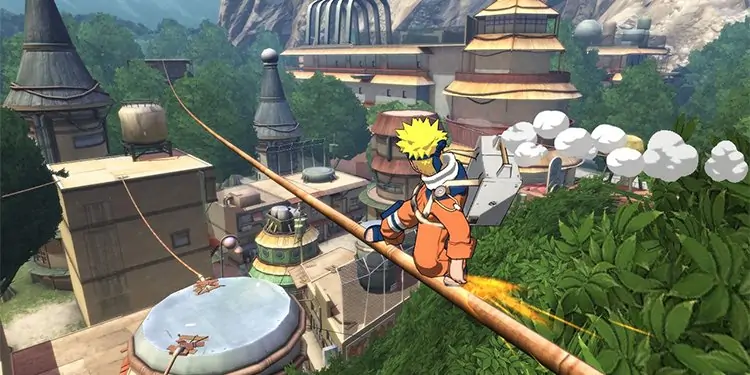
Rise of Ninja debuted in 2007 for Xbox 370. It’s an action-adventure title within the Naruto franchise and the first Naruto game made by a non-Japanese studio.
The title has two game modes. The first is a 1v1 2D combat scenario; the second is an RPG mode where Konoha is the main hub for various missions. The story alternates the two modes and follows the series until the Invasion of Konoha arc. Then, it delivers a 3D action platformer gameplay, 1v1 brawls, and minor character progression.
Naruto: Clash of Ninja Revolution – October 2007
Three other Clash of Ninja games debuted in Japan. Finally, Clash of Ninja Revolution became available worldwide in 2007 for the Nintendo Wii.
The game covers the Chunin Arc and the Search for Tsunade arcs. Then, it brings improved gameplay, new characters, and Nunchuk controller schemes.
Naruto Shippuden: Ultimate Ninja 5 – December 2007
The next entry of the Ultimate Ninja series debuted in 2007 for PlayStation 2. It has 62 anime characters and follows the Kazekage Rescue and Sasuke arcs.
It’s very similar to previous entries in the series. One of the few additions is “assist characters.” You choose them and call them during the battle for extra damage. Certain assist combinations create unique combos. Lastly, the story mode allows players to control other characters like Sakuna and Kakashi.
Naruto Shippūden: Ninja Destiny 2 – April 2008
Ninja Destiny 2 debuted in 2008 for Nintendo DS. Like the previous game in the series, it follows the events in the game with a story mode and a free battle mode.
The title has Naruto: Shippūden characters and follows the initial arc of the anime series.
Naruto: Path of the Ninja 2 – October 2008
Path of the Ninja 2 is the next entry of the turn-based JRPG. It debuted in 2008 for the Nintendo DS.
The game features similar gameplay as before. However, it follows an original story, and you control the Team 7 Shinobis.
Naruto: Clash of Ninja Revolution 2 – October 2008
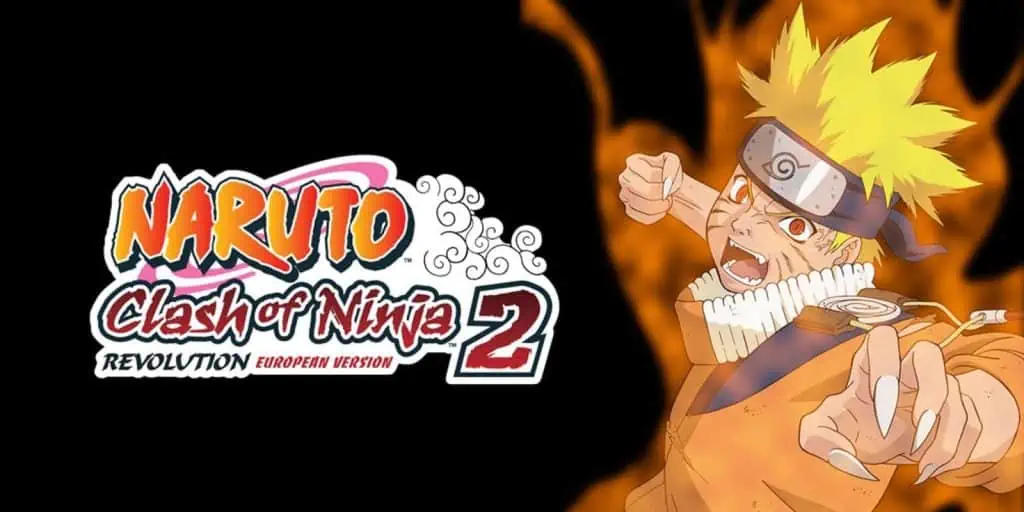
The next international entry in the Clash of Ninja series debuted in 2008 for Nintendo Wii.
Compared to previous series’ games, it has a story mode with an original story, right after Sasuke Uchiha betrays Konoha. There’re also other gameplay modes and about 10 missions for each of the 30 characters.
Naruto: Ultimate Ninja Storm – November 2008
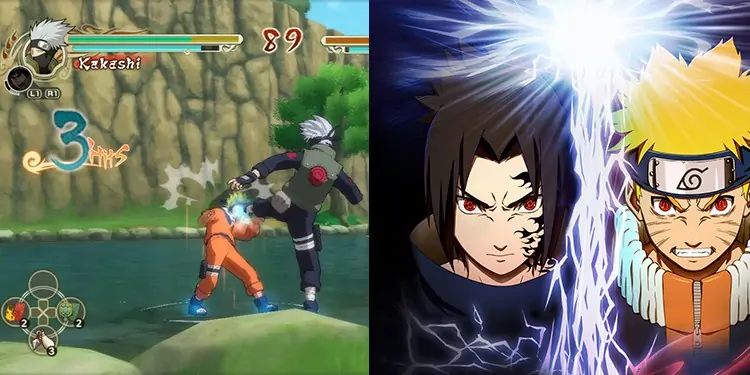
The opening title of the Ultimate Ninja Storm series by CyberConnect debuted for PlayStation 3 in 2008. It’s currently available for PS4, Xbox One, Windows, and Nintendo Switch.
Ninja Storm evolves the Ultimate Ninja gameplay with 3D environments, anime-like graphics, and a camera movement that smoothly follows character movements. Also, it introduces the “Awakening Mode,” a transformation that becomes available at low health.
Naruto: The Broken Bond – November 2008
The Broken Bond debuted for Xbox 360 in 2008. It’s a Ubisoft fighting game, a sequel to Rise of a Ninja.
This game follows the Search for Tsunade and Sasuke Retrieval arcs. You play it through similar mechanics as before, via 2D combat, 3D platforming, and Konoha as the main hub.
Naruto Shippuden: Ninja Council 4 – June 2009
The next Ninja Council installment is an action-based story-driven game. It debuted for the Nintendo DS in 2007.
The story follows the start of Naruto: Shippūden is an action 2D platformer. The events lead to Naruto, Sakura, and Chiyo rescuing Gaara from Akatsuki.
Naruto Shippūden: Legends: Akatsuki Rising – September 2009 (Uzumaki Chronicles Series)
Akatsuki Rising debuted in 2009 for the PSP. The game has 17 anime characters, including Akatsuki members.
It has fast 3D battles where each character has its own style and Jutsus. There’s also a versus mode and a co-op mode. Lastly, the story mode has 10 chapters across original and series events.
Naruto Shippuden: Clash of Ninja Revolution 3 – November 2009
Naruto Shippuden: Clash of Ninja Revolution 3 – November 2009
The fight worldwide available Clash of Ninja game debuted for the Nintendo Wii in 2009.
The title covers the Kazekage Rescue arc and has 40 playable characters. It also introduces multiplayer matches, co-op fights, Latent Ninja powers, and a new combat system. For example, players can perform a special attack with their teammates.
Naruto Shippuden: Dragon Blade Chronicles – November 2009
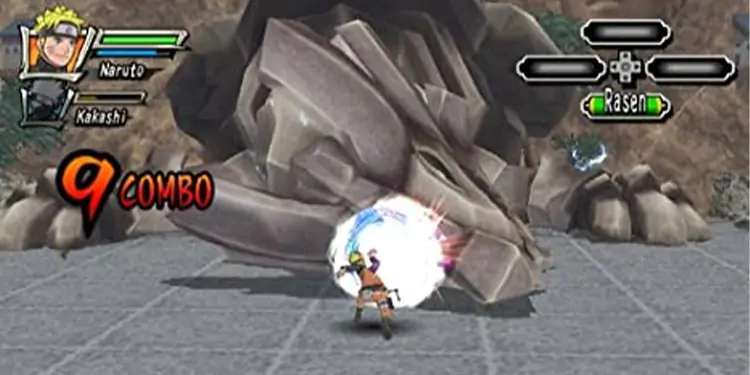
Dragon Blade Chronicles debuted in 2009 for the Wii in Japan. It reached international markets in 2010. In essence, it celebrates the 10th anniversary of the Naruto anime.
The game features a free-roaming hack&slash gameplay. However, it uses similar graphics and character models as the Clash of Ninja series. Lastly, the original story revolves around dragons protecting an ancient power from the villain Kuroma Tatsuhiro.
Naruto Shippuden: Ultimate Ninja Heroes 3 – December 2009
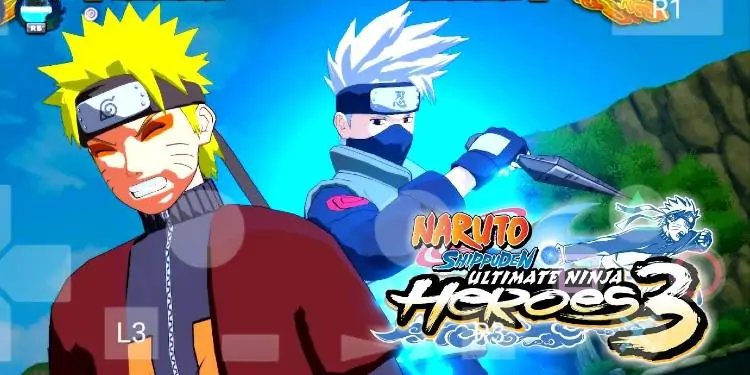
The game debuted in 2009 for PlayStation Portable. It has 50 characters, two of which are original.
The game features a unique story arc, as well as versus battles. Like the previous Ninja Hero games, it has a 2D combat with block, dodge, chakra, Jutsu, and combo mechanics.
Naruto Shippuden: Shinobi Rumble – April 2010 (Ninja Council series)
Shinobi Rumble debuted for the Nintendo DS in 2010. It follows similar mechanics as previous games, although it overhauls the story mode.
The campaign follows 21 chapters you can play with manga and anime characters. These are parallel and secret missions; most of them are unique to the game. Also, as you progress through the story mode, you’ll unlock secret Jutsus and characters.
Naruto Shippūden: Kizuna Drive – July 2010 (Uzumaki Chronicles series)
Kizuna Drive debuted in 2010 for PSP. It brings back similar gameplay as previous games in the series and game modes.
Nevertheless, the title follows an original story. The titular character travels to a village to defeat powerful enemies in a story mode with over 60 chapters.
Naruto Shippūden: Ultimate Ninja Storm 2 – October 2010
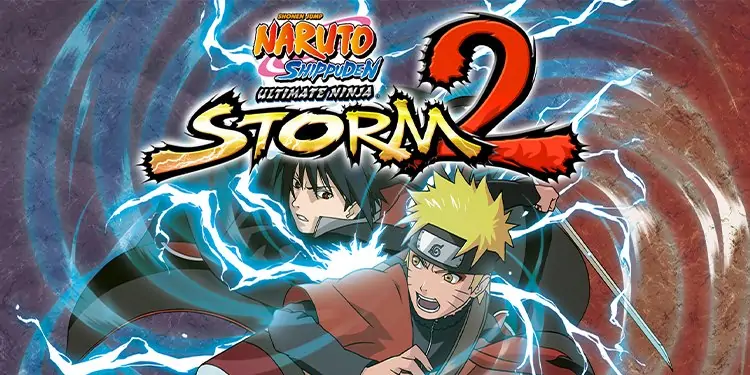
The next fighting game by CyberConnect 2 debuted in 2010 for PlayStation 3. It’s currently available for PS4, Xbox One, and Windows.
The story mode features Naruto Uzumaki fighting against Akatsuki members across nine chapters. Other than that, it retains the elements of the previous Ninja Storm game, with new combos, Jutsus, and unlockable Ultimate Jutsus.
Lastly, support characters come back with new mechanics. First, supports can Guard, Attack, or do both as the Balanced choice. Players can either summon the support or act for themselves to perform an offensive, defensive, or balanced ability.
Naruto Shippuden: Naruto vs. Sasuke – November 2010 (Ninja Council series)
Naruto vs. Sasuke debuted in 2008 for Nintendo DS. As the Clash of Clan series, it adds special tag-team attacks.
Also, the game made the character models smaller, so there’s more action on the screen. Lastly, it had new characters and side missions.
Naruto Shippūden 3D: The New Era – May 2011 (Ninja Council series)
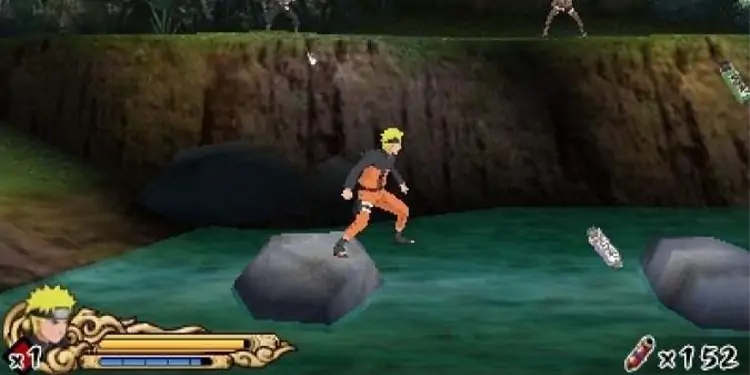
The last entry in the Ninja Council series debuted in 2011 for Nintendo 3DS.
It’s a side-scrolling adventure game with 2.5D graphics. The protagonist is Naruto Uzumaki, and the story follows his training in Mount Myōboku all the way to an original war story arc.
Naruto Shippuden: Ultimate Ninja Impact – October 2011
It debuted for PlayStation Portable in 2011 and has similar gameplay as previous Ninja Heroes games.
The title covers the events from the Kazekage Rescue arc to the Five Kage Summit Arc. Across the campaign, you’ll face boss battles, rush battles, and 1v100 battles- There’s also a multiplayer mode and a versus mode with 26 playable characters.
Naruto Shippuden: Ultimate Ninja Storm Generations – February 2012
It debuted in 2012 for PlayStation 3 and Xbox 360 as part of the Ultimate Ninja series.
The title features characters from two incarnations of the anime series, as their younger and older versions. Then, the gameplay became faster and more complex. Additionally, the title adds collectible cards and an original storyline by Studio Pierrot (Naruto animators).
Naruto Powerful Shippuden – November 2012
Powerful Shippuden debuted for Nintendo 3DS in 2012. It’s based on the Naruto spin-off manga Rock Lee no Seishun Full-Power Ninden.
It features 2D battles with “Chibi” designs, cutesy character models. The story follows Naruto and Rock Lee on a series of missions alongside their masters.
Naruto Shippuden: Ultimate Ninja Storm 3 – March 2013
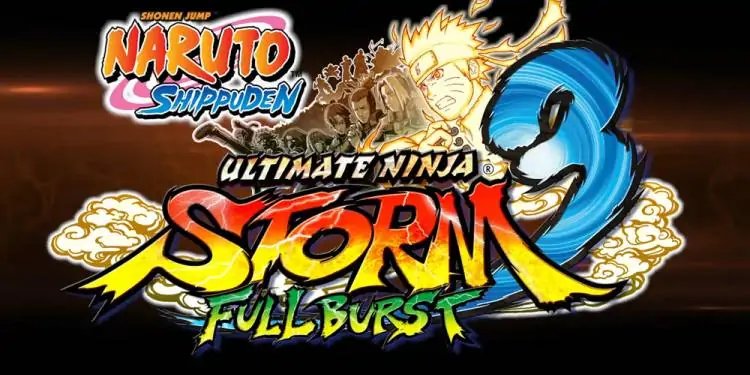
The game debuted for PlayStation 3 and Xbox 360 in 2013. It’s also available for PS4, Xbox One, Windows, and Nintendo Switch (HD remaster).
First, it packs a story mode that focuses on Naruto fighting against Akatsuki members and the Great Ninja War. The campaign leans into the hack & slash genre and adds quick-time events and complex box battles.
Then, the gameplay brought 80 playable characters (young and older version), seven support characters, and an overhauled battle system. The game became faster and focused on dodges, blocks, guards, and swapping places with a wood chunk. Also, the item system adds ways to buff, heal the player, or damage the opponent.
Naruto Shippuden: Ultimate Ninja Storm Revolution – September 2014
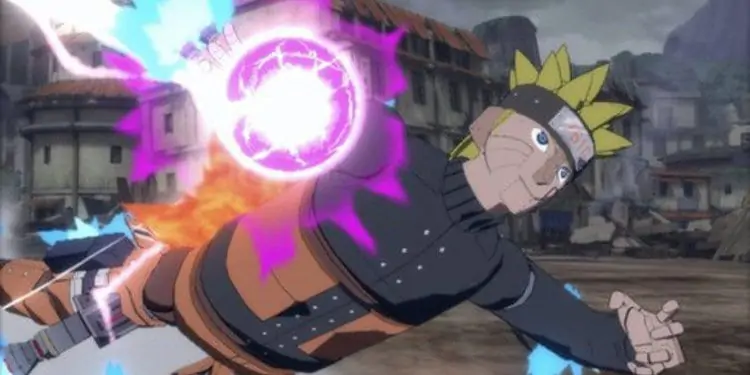
The next entry debuted in 2014 for PS4, Xbox One, and Windows. In 2020, it premiered for Nintendo Switch as well.
This title further revamps the Ultimate Ninja fighting system. So, it delivers counterattacks, guard breaks, team-tag special skills, and a Mecha-Naruto character. Similarly, it has a tournament game mode where players can fight against three AI fighters in a Battle Royale.
The story mode follows three original stories. The first campaign follows Obito, Yahiko, and Nagato during the organization’s first days. The second part of the story tells the death of Shisui Uchiha. The last part of the story follows Naruto’s mother, Kuchina, interacting with young Obito and Minato.
Naruto Shippuden: Ultimate Ninja Storm 4 – February 2016
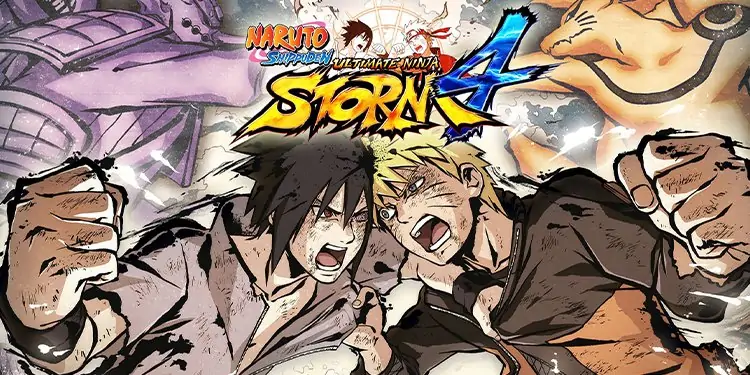
The last entry of the Ultimate Ninja Storm series debuted in 2016 for PS4, Xbox One, and Windows.
The story follows Naruto and Sasuke during the Fourth Shinobi World War arc. Both unite to defeat Obito, Madara, Kabuto, the Bijuu, and eventually Kaguya. As before, there’re boss fights, hack & slash scenes, cut-scenes, and quick-time events.
It has similar gameplay as Ultimate Ninja 3. A subsequent expansion, Road to Boruto, added Boruto alongside other characters of the anime sequel.
Naruto x Boruto: Ninja Voltage – 2017
Ninja Voltage debuted for iOS and Android. It’s an action RPG with strategy elements based on Naruto and Boruto anime.
The gameplay is about infiltrating other players’ bases for combat. Additionally, players can create their own forts with traps, defensive options, and similar.
Naruto to Boruto: Shinobi Striker – August 2018
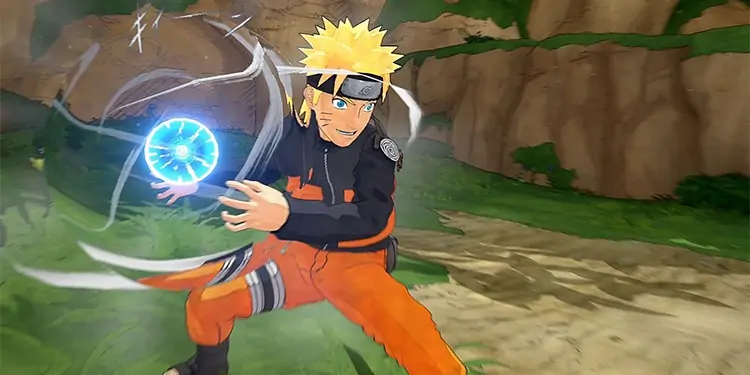
Naruto to Boruto debuted in 2018 for PS4, Xbox One, and Windows. It’s the first full multiplayer game in the Narutoverse.
The game brings back the franchise to consoles with completely new mechanics. It allows players to create their Shinobi, choose one of the 4 “roles,” skills, and apparel. Combat is free format, fluid, and smooth.
Then, you can use the avatar to join PvP arenas. The gameplay can be fun, but the game is barebones outside of the multiplayer mode. For example, some missions allow your character to become a Chunin and then a Jounin.
Every Naruto Games in Chronological Order
- Naruto: Clash of Ninja 1 – April 2003
- Naruto: Ninja Council – May 2003
- Naruto: Ultimate Ninja – October 2003
- Naruto: Clash of Ninja 2 – December 2003
- Naruto: Ninja Council 2 – April 2004
- Naruto: Path of the Ninja – July 2004
- Naruto: Ultimate Ninja 2 – September 2004
- Naruto: Ninja Council 3 – April 2005
- Naruto: Uzumaki Chronicles – August 2005
- Naruto Ultimate Ninja 3 – December 2005
- Naruto: Ultimate Ninja Heroes 2: The Phantom Fortress – March 2006
- Naruto: Ninja Destiny – December 2006
- Naruto Shippūden: Ultimate Ninja 4 – April 2007
- Naruto: Ultimate Ninja Heroes – August 2007
- Naruto: Uzumaki Chronicles 2 – September 2007
- Naruto: Rise of a Ninja – October 2007
- Naruto: Clash of Ninja Revolution – October 2007
- Naruto Shippuden: Ultimate Ninja 5 – December 2007
- Naruto Shippūden: Ninja Destiny 2 – April 2008
- Naruto: Path of the Ninja 2 – October 2008
- Naruto: Clash of Ninja Revolution 2 – October 2008
- Naruto: Ultimate Ninja Storm – November 2008
- Naruto: The Broken Bond – November 2008
- Naruto Shippuden: Ninja Council 4 – June 2009
- Naruto Shippūden: Legends: Akatsuki Rising – September 2009 (Uzumaki Chronicles Series)
- Naruto Shippuden: Clash of Ninja Revolution 3 – November 2009
- Naruto Shippuden: Dragon Blade Chronicles – November 2009
- Naruto Shippuden: Ultimate Ninja Heroes 3 – December 2009
- Naruto Shippuden: Shinobi Rumble – April 2010 (Ninja Council series)
- Naruto Shippūden: Kizuna Drive – July 2010 (Uzumaki Chronicles series)
- Naruto Shippūden: Ultimate Ninja Storm 2 – October 2010
- Naruto Shippuden: Naruto vs. Sasuke – November 2010 (Ninja Council series)
- Naruto Shippūden 3D: The New Era – May 2011 (Ninja Council series)
- Naruto Shippuden: Ultimate Ninja Impact – October 2011
- Naruto Shippuden: Ultimate Ninja Storm Generations – February 2012
- Naruto Powerful Shippuden – November 2012
- Naruto Shippuden: Ultimate Ninja Storm 3 – March 2013
- Naruto Shippuden: Ultimate Ninja Storm Revolution – September 2014
- Naruto Shippuden: Ultimate Ninja Storm 4 – February 2016
- Naruto x Boruto: Ninja Voltage – 2017
- Naruto to Boruto: Shinobi Striker – August 2018

